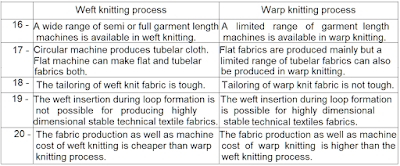WEFT KNITTING:-
Weft knitting Manufacture (Detail):-
Weft knitting is a knitted piece of fabric where the stitches run from left to right horizontally across the fabric. It is usually knitted with one piece of yarn, and can be made either by hand or using a knitting machine. Weft knitting is the most common form of knitting as it is simpler than warp knitting, the other form of knitting.
Weft knitting was the first type of knitting invented, Stockinette stitch is the most common form of stitch used and it was first discovered in artefacts from as early as the 11th Century. Many other stitches can be used in weft knitting such as Purl, Double knitting, and patterns such as Cable, Fair Isle and Aran can be achieved using different yarns in different colours and weights.
The knitting machine was invented to speed up the manufacturing process of knitted products. It also meant that patterns were more calculated and symmetrical. It also meant that less mistakes were made as it is harder to drop stitches and cause ladders. Nowadays many of the knitted garments that are ma SWss produced are produced in factories using knitting machines.
Types of Weft knitting include Jersey, Double Knit, Circular Knitting, Fair Isle and Cable knit. All of these knits are generally produced using a knitting machine as a finer gauge, more delicate fabric can be produced but hand knitting is still used, mainly as a hobby nowadays.
Properties of weft knitting:-
(1) Very elastic.
(2) Warm to wear.
(3) Comfortable.
(4) Shrinks easily.
(5) Different properties can be achieved depending on the yarns used
Can stretch out of shape easily.
(6) Does not fray.
(7) Unravels when cut.
(8) Curls up at the edges.
(9) Various colours/patterns can be achieved.
(10) Good Insulator.
End uses of Weft knitting:-
(1) Underwear.
(2) Hosiery.
(3) T-Shirts.
(4) Sportswear.
(5) Baby Clothes.
(6) Pyjamas.
(7) Knitwear such as Jumpers, Scarves, Hats and Gloves.
ref:-https://www.catwalkyourself.com
Difference between weft knitting and warp knitting:-





Comments
Post a Comment